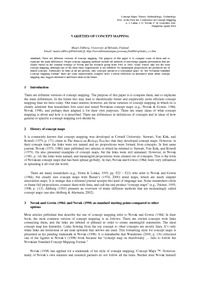Varieties of Concept MappingMauri Åhlberg
|
 |
 Diese Seite wurde seit 15 Jahren inhaltlich nicht mehr aktualisiert.
Unter Umständen ist sie nicht mehr aktuell.
Diese Seite wurde seit 15 Jahren inhaltlich nicht mehr aktualisiert.
Unter Umständen ist sie nicht mehr aktuell.
 Zusammenfassungen
Zusammenfassungen
There are different versions of concept mapping. The purpose of this paper is to compare some of them and to
explicate the main differences. Proper concept mapping methods include all methods of knowledge graphic presentation that are
clearly based on the seminal writings of Novak and his research group from 1981 to 2002. Some writers may use the term
concept mapping, although one of the most basic requirements is not fulfilled: No meaningful propositions are produced out of
linked concepts. Sometimes no links at all are present, only concepts spread in a conceptual space. In "the Novakian Standard
Concept Mapping Format" there are some unnecessarily complex rules. Critical reflection on alternative ideas about concept
mapping may suggest alternative and better ideas in the future.
Von Mauri Åhlberg im Konferenz-Band Concept Maps: Theory, methodology, technology (2005) im Text Varieties of Concept Mapping  Varieties of concept mapping approaches have recently been outlined by Âhlberg (2004). According to Âhlberg, the only mapping techniques that deserve the label concept mapping are those that are both clearly based on the seminal writings of Novak and his research group from 1981 to 2002 and that fulfill the basic requirement that meaningful propositions may be produced out of linked concepts. He points out that in following Novak´s standards, there are some unnecessarily complex rules, which may be overcome in the future. For example, he suggests that improved concept maps may also include whole phrases to signify the meaning of a concept instead of short labels, that multimedia resources may be connected to maps, and that, in some cases, numbers may be included showing the order in which the propositions should be read.
Varieties of concept mapping approaches have recently been outlined by Âhlberg (2004). According to Âhlberg, the only mapping techniques that deserve the label concept mapping are those that are both clearly based on the seminal writings of Novak and his research group from 1981 to 2002 and that fulfill the basic requirement that meaningful propositions may be produced out of linked concepts. He points out that in following Novak´s standards, there are some unnecessarily complex rules, which may be overcome in the future. For example, he suggests that improved concept maps may also include whole phrases to signify the meaning of a concept instead of short labels, that multimedia resources may be connected to maps, and that, in some cases, numbers may be included showing the order in which the propositions should be read. Dieses Konferenz-Paper erwähnt ...
Dieses Konferenz-Paper erwähnt ...
 Personen KB IB clear | Tony Buzan , Barry Buzan , Alberto J. Cañas , Natalia Derbentseva , D. B. Gowin , Joseph D. Novak , Frank Safayeni | ||||||||||||||||||||||||||||||||||||
 Aussagen KB IB clear | Concept Maps sind nicht das Gleiche wie Mind Maps | ||||||||||||||||||||||||||||||||||||
 Begriffe KB IB clear | Concept MapConcept Map
, Cyclic Concept MapCyclic Concept Map
,  Mind Map Mind Map Mind Map Mind Map
| ||||||||||||||||||||||||||||||||||||
 Bücher |
| ||||||||||||||||||||||||||||||||||||
 Texte |
|
 Dieses Konferenz-Paper erwähnt vermutlich nicht ...
Dieses Konferenz-Paper erwähnt vermutlich nicht ... 
 Nicht erwähnte Begriffe | Concept Mapping Software, Mappingverfahren |
 Tagcloud
Tagcloud
 Zitationsgraph
Zitationsgraph
 Zitationsgraph (Beta-Test mit vis.js)
Zitationsgraph (Beta-Test mit vis.js)
 3 Erwähnungen
3 Erwähnungen 
- Knowledge and Information Visualization - Searching for Synergies (Sigmar-Olaf Tergan, Tanja Keller) (2005)
- Interaktive Maps - Zugriffsinstrumente auf große Textmengen (Raja Gumienny) (2007)


- Handbook of Research on New Media Literacy at the K-12 Level (Leo Tan Wee Hin, R. Subramaniam) (2009)


- Concept Mapping as a Mediator of Constructivist Learning (Gregory MacKinnon)


- Concept Mapping as a Mediator of Constructivist Learning (Gregory MacKinnon)
 Volltext dieses Dokuments
Volltext dieses Dokuments
 |  Varieties of Concept Mapping: Artikel als Volltext ( Varieties of Concept Mapping: Artikel als Volltext ( : :  , 35 kByte; , 35 kByte;  : :  2021-03-21) 2021-03-21) |
 Anderswo suchen
Anderswo suchen 
 Beat und dieses Konferenz-Paper
Beat und dieses Konferenz-Paper
Beat war Co-Leiter des ICT-Kompetenzzentrums TOP während er Dieses Konferenz-Paper ins Biblionetz aufgenommen hat. Die bisher letzte Bearbeitung erfolgte während seiner Zeit am Institut für Medien und Schule. Beat besitzt kein physisches, aber ein digitales Exemplar. Eine digitale Version ist auf dem Internet verfügbar (s.o.). Aufgrund der wenigen Einträge im Biblionetz scheint er es nicht wirklich gelesen zu haben. Es gibt bisher auch nur wenige Objekte im Biblionetz, die dieses Werk zitieren.











 (
( Biblionetz-History
Biblionetz-History